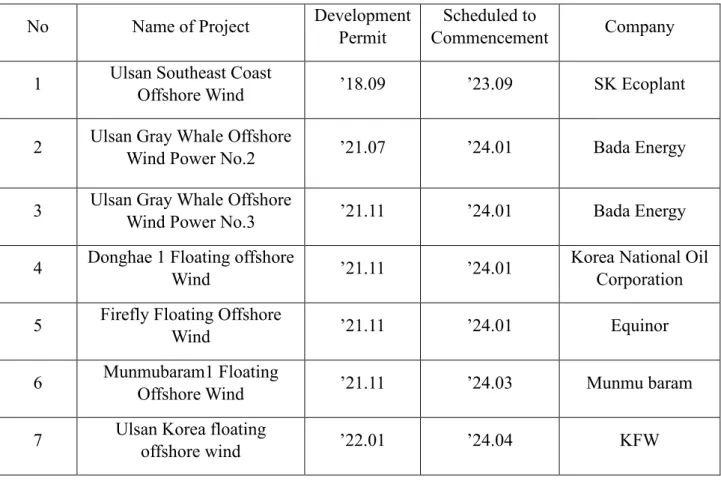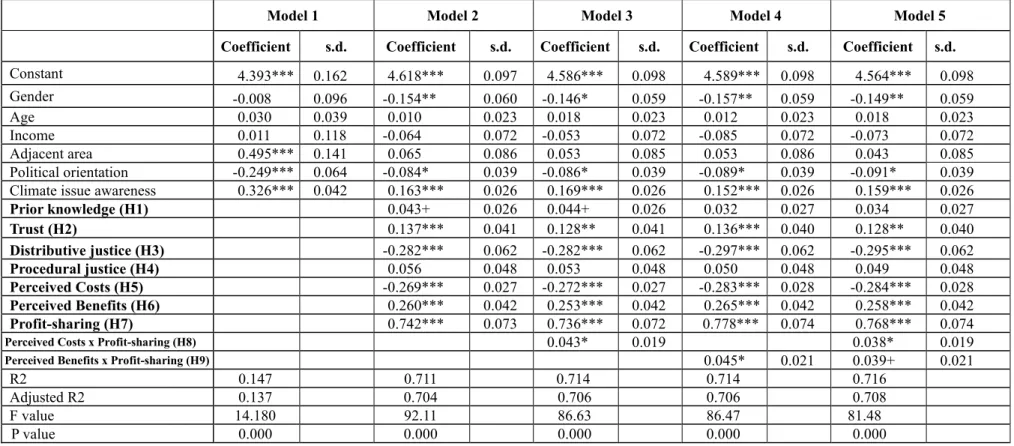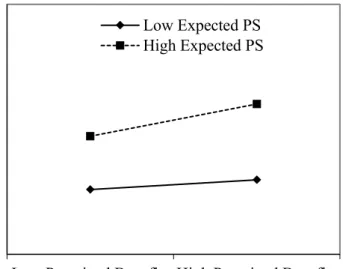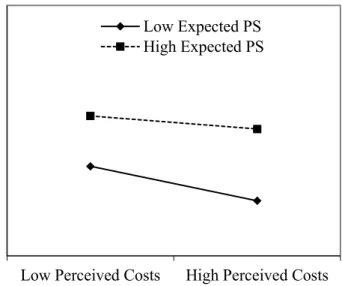This thesis investigates the determinants of public acceptance of the development of a floating offshore wind farm in Ulsan, highlighting the role of community profit-sharing schemes. As many examples at home and abroad have shown, public acceptance is a key factor in the success of large-scale renewable energy projects. Although there are many factors influencing public acceptance, profit-sharing schemes for local communities have recently attracted much attention from both local residents and policy makers.
INTRODUCTION
In addition, our findings provide practical suggestions for an effective way to improve public acceptance of offshore wind generation through profit-sharing schemes. The thesis is organized as follows: first, we examine the existing literature on public acceptance of offshore wind energy. Second, we provide essential information on the current state of offshore wind power at home and abroad, followed by the introduction of the Ulsan Offshore Wind Power Project.
THEORETICAL BACKGROUND AND HYPOTHESES
- Global Offshore Wind Power
- Offshore Wind Power in Korea
- Korean Policy to Improve Residents’ Acceptance of Renewable Energy
- Public Acceptance of Offshore Wind Power Projects
- Hypothesis Development on Ulsan’s Offshore Wind Power
The findings of this thesis drawn from a survey of 500 residents in Ulsan will expand our understanding of the role of profit-sharing schemes on the acceptability of offshore wind power generation, which has so far been understudied despite its growing importance. As such, offshore wind power projects face problems due to the lack of local residents' support. Specifically, Section 27-2 of the New Renewable Energy Act and RPS Notice 16 stipulate that local residential areas such as Eup/Myeon/Dong where solar and wind power plants are located can participate in the development of new and renewable energy projects.
Among them, 138 cases were solar energy projects and two cases were wind energy, but none were offshore wind energy projects. In order to make residents' acceptance policies more effective, the Korean government recently formed a task force on offshore wind energy and is considering various policy adjustments to overcome the above-mentioned limitations. Furthermore, Ulsan Metropolitan City proposed at the local government level to institutionalize the benefit-sharing arrangement for residents to improve residents' acceptability of floating offshore wind power generation.
In this scheme, shared profits are used for local community development, including facilities and supporting infrastructure related to wind energy projects, as well as resident welfare activities such as road paving, village councils. There has been a series of research on public acceptance of offshore wind energy in many different countries using different research methods. Dong-ho Lee (2020) reviewed domestic and foreign literature on wind energy acceptance, classified residents' acceptance factors, and presented an exploratory research model.
The data from the survey on the adoption of wind energy by the residents was analyzed with structural equation PLS (PLS-SEM). Firestone and Kempton (2007) found that residents are more likely to support the project if the offshore wind farm project is managed by a local government rather than a private company. Specifically, in the case of offshore wind farm projects, local fishermen have perceived declines in fish populations due to the effects of noise and water quality degradation (Ten Brink and Dalton, 2018).

METHODS
- Research Setting
- Sample and Data Collection
- Measurements
- Analysis
Public acceptance was measured with four items by asking respondents to rate the extent to which they agree with the following policies: (1) policy to expand the elixir of offshore wind power in Korea's electricity generation, (2) policy to build UFOWF- the project, (3) policy to continuously promote the UFOWF project to create jobs and revitalize the local economy, and (4) policy to promote the UFOWF project as Ulsan's main industry such as shipbuilding. Trust in decision makers who run projects that can affect our lives has long been studied as an influential factor in public acceptance. Trust in this study was measured with five items by asking respondents to rate the degree to which they trust the following institutions related to the UFOWF project: (1) Ministry of Trade, Industry and Energy (government department responsible for offshore wind) , ( 2) Local government (Ulsan City), (3) Public institutions (energy companies), (4) Global private energy company, and (5).
Respondents were asked to rate the extent to which they agree with the following four points: (1) the benefits of offshore wind energy will be fairly distributed among communities; (2) compensation for damage caused by. In doing so, we adopted items from previous studies on public acceptance of sustainable energy and nuclear projects (Choi Jinsik, 2008; Kim Taehyun, 2015). The costs in this survey were measured by asking respondents to rate the extent to which they agree with the following nine items: (1) offshore wind energy would be dangerous; (2) I am afraid of accidents caused by offshore wind energy; (3) there are concerns about noise and vibrations caused by offshore wind energy; (4) there are concerns about the destruction of marine habitats, such as declines in fish species due to offshore wind energy; (5) there are concerns about damage to the aesthetic landscape due to offshore wind energy; (6) offshore wind energy will reduce the price of nearby properties; 7) offshore wind energy can create a bad image for the region and cause regional losses; (8) accidents are likely to occur at offshore wind farms; and (9) an accident at an offshore wind farm would be fatal.
We measured Benefits by asking respondents to determine the extent to which they agree with the following six items: (1) there will be personal economic benefits from offshore wind; (2) offshore wind power will economically benefit the area where I live; (3) offshore wind power will create more jobs; (4) offshore wind power will increase cultural, educational and medical facilities; (5) new fishing grounds will be created using offshore wind power facilities; and (6) offshore wind power will increase investment in industrial ports. Respondents' expectation about the likelihood and effect of a profit sharing scheme was measured with four items by reflecting the profit sharing proposals discussed in Ulsan. Respondents were asked to give their opinion on the likelihood and effectiveness of two profit-sharing schemes as follows: (1) a resident-participatory profit-sharing system will be introduced in which citizens make investments such as equity participation in offshore wind power projects and share power generation profits; (2) the resident participatory profit sharing system will be of practical benefit to Ulsan citizens.
Adjacent area, indicating areas close to the site (construction of offshore wind farms), was included in the analysis with a dummy variable, a value of 0 for no, and 1 for yes.

RESULTS
To reduce the impact of some significant correlations on the estimates, the variables included in the interaction terms were centered, and our results suggested that multicollinearity is not a serious concern in the analysis (mean line is 2.37). The results show that contiguous area, political orientation, awareness of climate issues were significantly related to public acceptance. In Models 3 and 5, the interaction term between perceived costs and profit sharing has a positive and significant coefficient (0.043, p ≤ 0.05).
The graph shows that the impact of high costs on public acceptance becomes less negative when profit sharing is high. In models 4 and 5, the interaction term between perceived benefits and profit sharing has a positive and significant coefficient (0.045, p ≤ 0.05). The graph shows that the impact of benefit enhancement on public acceptance is greater when profit sharing is high than when profit sharing is low, supporting Hypothesis 9.
DISCUSSION AND CONCLUSION
Theroetical and Practical Implications
First, this thesis is an early study that empirically examined the effect of profit-sharing schemes on public acceptance of an offshore wind farm project. Previous studies using conceptual models, examples and analytical tools (Lee Dong-ho, 2020; Kim et al., 2020) have shown that profit-sharing schemes are likely to be the most effective policy tool for increasing the adoption of offshore wind energy by local residents. However, little was empirically known about the effectiveness of such profit-sharing schemes on public acceptance.
Our results showed that profit-sharing schemes are the most influential factor in increasing public acceptance among the factors identified in the literature to date. These findings strongly suggest that governments should consider introducing profit-sharing schemes to increase public acceptance of their offshore wind projects. For example, we have not taken into account the difference between resident-led and local authority-led profit sharing schemes.
Since residents' views on the need for individual and community benefits directly through offshore wind energy. Second, this thesis revealed that gain-sharing schemes are important not only because they have direct effects on improving public acceptance, but also because they can mitigate the negative impact of perceived costs/risk factors and further increase acceptance. Third, it is interesting to note that, contrary to our conjecture about the positive effect of distributive justice on public acceptance, our results report a negative effect, indicating that since Ulsan residents believe that the benefits of offshore wind energy will be distributed more fairly among the local population and community and that the damage caused by offshore wind energy will be compensated more fairly, they are generally less accepted.
After reporting these incomplete results, we suggest future research focusing on the measurement and methodological aspects of distributive and procedural justice in the context of offshore wind energy projects.
Conclusion
Further, this thesis verified the influences of well-established factors on public acceptance in the context of Korean offshore wind energy projects. Korea Ministry of Trade, Industry and Energy, Ministry of Oceans and Fisheries, Ministry of Environment, 2020, Plan for Offshore Wind Energy Production in Cooperation with Local People and Fishing Industry (OSW Cooperation Plan). Korea Ministry of Trade, Industry and Energy, 2022, 3rd Joint Public-Private Offshore Wind Energy TF Meeting.
Article 27-2 of the Korean Renewable Energy Law (Participation of Residents in New and Renewable Energy Generation Business). Social acceptance of renewable energy innovation: An introduction to the concept. 2020), A Study on the Acceptance Pattern of Construction and Siting of Offshore Wind Farms in the Coastal Areas of Korea. Lee, Sang-Hoon, Yun, Seong-Gwon.(2015). Review of measures to increase local acceptance of renewable energy projects. Environmental Law and Policy.
Using knowledge of artificial reefs to improve the ecological function of offshore wind turbine foundations: implications for fish abundance and diversity. The predominance of economic development in support for large-scale wind farms in the US. The social dynamics of turbine tourism and recreation: Introducing a mixed methods approach to the study of the first US offshore wind farm.
Community benefits, framing and the social acceptance of offshore wind farms: an experimental study in England.


